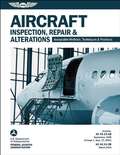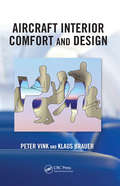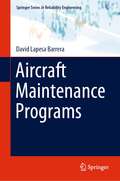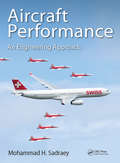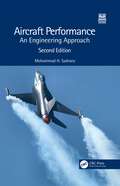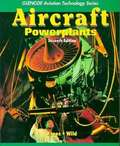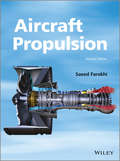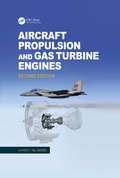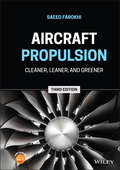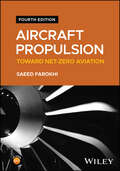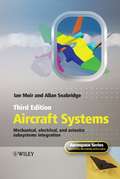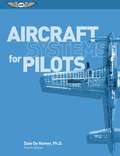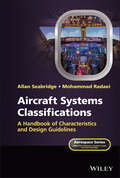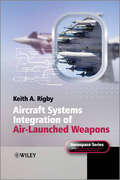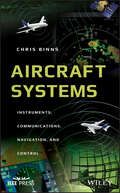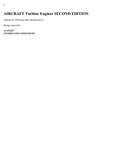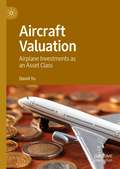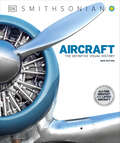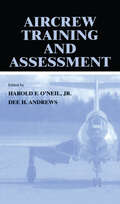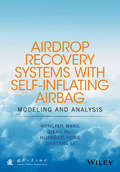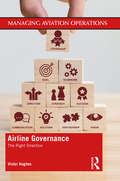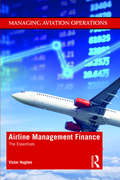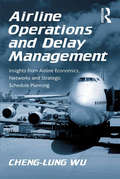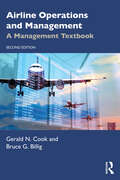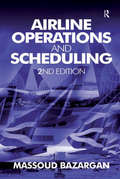- Table View
- List View
Aircraft Inspection, Repair and Alterations: Acceptable Methods, Techniques and Practices (FAA Ac 43. 13-1b/2b) (FAA Handbooks)
by Federal Aviation Administration (FAA)/Aviation Supplies and Academics (ASA) StaffThis handbook for Aviation Maintenance Technicians (AMTs), repair stations, aircraft owners and homebuilders details the standards for acceptable methods, techniques, and practices for the inspection, repair, and alteration of aircraft. It is a combination of the two most important Advisory Circulars (ACs) written by the Federal Aviation Administration (FAA) on this topicnamely, "Acceptable Methods, Techniques, and Practices: Aircraft Inspection and Repair" (AC 43.13-1B) and "Acceptable Methods, Techniques and Practices: Aircraft Alterations" (AC 43.13-2B) -- printed and bound into one volume and called the "AC 43.13-1B/2B." AC 43.13-1B provides details on the materials and practices, health and safety, inspection, repair, and finishes for wood structures, fabric covering, fiberglass and plastics, and metal structures, welding and brazing. It includes chapters dedicated to nondestructive inspection (NDI), corrosion, inspection and protection, aircraft hardware, control cables and turnbuckles, engines, fuel, exhaust, propellers, aircraft systems and components, weight and balance, electrical systems, avionics, and human factors. AC 43.13-2B is a manual filled with details and instructions for the installation of aircraft components and systems, such as communications, navigation, and emergency systems, anticollision and supplementary lights, skis, oxygen systems in nonpressurized aircraft, rotorcraft external-load devices, cargo slings and external racks, glider and banner tow-hitches, aircraft batteries and more, including guidance on adding or relocating instruments. These combined manuals provide this pertinent information where no manufacturer repair or maintenance instructions exist. The details and standards for methods and practices covered are applicable to non-pressurized civil aircraft with a gross weight of 12,500 pounds or less. Illustrated throughout; includes a glossary, and a list of useful acronyms and abbreviations.
Aircraft Interior Comfort and Design (Ergonomics Design & Mgmt. Theory & Applications)
by Peter VinkWhat should every airline and manufacturer know about comfort?What can we learn from studies in the scientific literature?What do most passengers know about comfort and how can we translate that into interior design?Where can I find the latest knowledge and research useful for designing aircraft seats?Although the answers to these questions are ava
Aircraft Maintenance Programs (Springer Series in Reliability Engineering)
by David Lapesa BarreraThis book provides the first comprehensive comparison of the Aircraft Maintenance Program (AMP) requirements of the two most widely known aviation regulators: the European Aviation Safety Agency (EASA) and the Federal Aviation Administration (FAA). It offers an in-depth examination of the elements of an AMP, explaining the aircraft accident investigations and events that have originated and modelled the current rules. By introducing the Triangle of Airworthiness model (Reliability, Quality and Safety), the book enables easier understanding of the processes by which an aircraft and its components are deemed to be in a safe condition for operation from a cost-effective and optimization perspective. The book compares the best practices used by top airlines and compiles a series of tools and techniques to improve the standards of the AMP. Aircraft maintenance engineers, students in the field of aerospace engineering, and airlines staff, as well as researchers more widely interested in safety, quality, and reliability will benefit from reading this book
Aircraft Performance: An Engineering Approach
by Mohammad H. SadraeyAircraft Performance: An Engineering Approach introduces flight performance analysis techniques that enable readers to determine performance and flight capabilities of aircraft. Flight performance analysis for prop-driven and jet aircraft is explored, supported by examples and illustrations, many in full color. MATLAB programming for performance analysis is included, and coverage of modern aircraft types is emphasized. The text builds a strong foundation for advanced coursework in aircraft design and performance analysis.
Aircraft Performance: An Engineering Approach
by Mohammad H. SadraeyAircraft Performance: An Engineering Approach, Second Edition introduces flight performance analysis techniques of fixed-wing air vehicles, particularly heavier-than-aircraft. It covers maximum speed, absolute ceiling, rate of climb, range, endurance, turn performance, and takeoff run.Enabling the reader to analyze the performance and flight capabilities of an aircraft by utilizing only the aircraft weight data, geometry, and engine characteristics, this book covers the flight performance analysis for both propeller-driven and jet aircraft. The second edition features new content on vertical takeoff and landing, UAV launch, UAV recovery, use of rocket engine as the main engine, range for electric aircraft, electric engine, endurance for electric aircraft, gliding flight, pull-up, and climb-turn. In addition, this book includes end-of-chapter problems, MATLAB® code and examples, and case studies to enhance and reinforce student understanding.This book is intended for senior undergraduate aerospace students taking courses in Aircraft Performance, Flight Dynamics, and Flight Mechanics.Instructors will be able to utilize an updated Solutions Manual and Figure Slides for their course.
Aircraft Powerplants (7th Edition)
by Michael J. Kroes Thomas W. WildAircraft Powerplants, Seventh Edition, part of the Glencoe Aviation Technology Series (formerly the Northrop Series), is the most comprehensive up-to-date powerplant book on the market today. It has been revised to reflect the latest changes in FAR Part 147 and changing industry needs. The new edition features expanded coverage of turbine engine theory and nomenclature. It also includes additional current models of turbofan, turboprop, and turboshaft engines. Information on turbine engine fuel, oil, ignition systems has been expanded and divided into separate chapters. And the remainder of the turbine engine material is updated and presented apart from reciprocating engines, allowing for the flexibility of teaching this materials separately or together.
Aircraft Propulsion
by Saeed FarokhiNew edition of the successful textbook updated to include new material on UAVs, design guidelines in aircraft engine component systems and additional end of chapter problemsAircraft Propulsion, Second Edition is a comprehensive textbook covering aircraft gas turbine engine and rocket propulsion from the basic principles to more advanced treatments in engine components. Propulsion system integration with aircraft plays an important role in understanding propulsion and is addressed accordingly. Extensive review material and derivations are included to help the reader navigate through the subject with more ease. In every engine component, issues related to manufacturing, material properties, temperature limitations and cooling are included to give an appreciation for the broader scope of propulsion engineering than just aero-thermodynamics. Component matching and off-design analysis is detailed in a separate chapter to provide the physical and performance linkage between the components and their impact on aircraft engines. Principles of chemical rocket propulsion are presented in the context of single-stage to orbit propulsion needs of a rocket-based combined cycle vehicle.The new edition of this textbook has been updated to include a new chapter on UAV propulsion, and the design guidelines in aircraft engine component systems have been expanded to make the book user friendly for component designers. New material on drop?]in biofuels and design for sustainability is also included to reflect FAA's 2025 Vision. Numerous end of chapter problems are included and a solutions manual is available on a companion website.New edition of the successful textbook updated to include new material on UAVs, design guidelines in aircraft engine component systems and additional end of chapter problemsContains over 100 examples designed to practice the principles learned in jet propulsion and compliment learning through applicationsCovers aircraft gas turbine engine and rocket propulsion from the basic principles to more advanced treatments in engine componentsConsiders propulsion system integration with aircraftAccompanied by a website hosting a solutions manualAn excellent textbook for Graduate and undergraduate students in aerospace and mechanical engineering.
Aircraft Propulsion and Gas Turbine Engines, Second Edition
by Ahmed F. El-SayedAircraft Propulsion and Gas Turbine Engines, Second Edition builds upon the success of the book’s first edition, with the addition of three major topic areas: Piston Engines with integrated propeller coverage; Pump Technologies; and Rocket Propulsion. The rocket propulsion section extends the text’s coverage so that both Aerospace and Aeronautical topics can be studied and compared. Numerous updates have been made to reflect the latest advances in turbine engines, fuels, and combustion. The text is now divided into three parts, the first two devoted to air breathing engines, and the third covering non-air breathing or rocket engines.
Aircraft Propulsion: Cleaner, Leaner, and Greener
by Saeed FarokhiExplore the latest edition of a leading resource on sustainable aviation, alternative jet fuels, and new propulsion systems The newly revised Third Edition of Aircraft Propulsion delivers a comprehensive update to the successful Second Edition with a renewed focus on the integration of sustainable aviation concepts. The book tackles the impact of aviation on the environment at the engine component level, as well as the role of propulsion system integration on fuel burn. It also discusses combustion emissions, including greenhouse gases, carbon monoxide, unburned hydrocarbons (UHC), and oxides of nitrogen (NOx). Alternative jet fuels, like second generation biofuels and hydrogen, are presented. The distinguished author covers aviation noise from airframe to engine and its impact on community noise in landing and takeoff cycles. The book includes promising new technologies for propulsion and power, like the ultra-high bypass (UHB) turbofan and hybrid-electric and electric propulsion systems. Readers will also benefit from the inclusion of discussions of unsteady propulsion systems in wave-rotor combustion and pulse-detonation engines, as well as: A thorough introduction to the history of the airbreathing jet engine, including innovations in aircraft gas turbine engines, new engine concepts, and new vehicles An exploration of compressible flow with friction and heat, including a brief review of thermodynamics, isentropic process and flow, conservation principles, and Mach numbers A review of engine thrust and performance parameters, including installed thrust, rocket thrust, and modern engine architecture A discussion of gas turbine engine cycle analysis Perfect for aerospace and mechanical engineering students in the United States and overseas, Aircraft Propulsion will also earn a place in the libraries of practicing engineers in the aerospace and green engineering sectors seeking the latest up to date resource on sustainable aviation technologies.
Aircraft Propulsion: Toward Net-Zero Aviation
by Saeed FarokhiUpdated edition of the successful textbook exploring cutting-edge developments in the field and Net-Zero aviation goals of 2050 Maintaining the successful foundation of previous editions, the fourth edition of Aircraft Propulsion is a forward-looking textbook on propulsion, from the basic principles to more advanced treatments in engine components and system integration, that focuses on the Net-Zero Aviation goals of 2050. This book explores the alphabet of the emerging technology in propulsion by emphasizing electrification and sustainable aviation fuels (SAF), including liquefied natural gas (LNG) and hydrogen. This book also covers advanced topics like flow control, adaptive cycle engines (ACE), hybrid-electric propulsion, pulse detonation engines (PDE), propulsion integration, and engine performance testing and instrumentation. Along with content updates, this new edition devotes a new chapter to supersonic and hypersonic propulsion. End-of-chapter problem sets are included as a learning aid with solutions available on a companion website. A quiz appendix with 45 10-minute quizzes helps readers test their knowledge at every stage of learning. Aircraft Propulsion includes information on: Engine thrust and performance parameters, gas turbine engine cycle analysis, and aircraft engine inlets and nozzles Combustion chambers and afterburners, axial-flow compressor and fan aerodynamics, centrifugal compressor aerodynamics and gas turbine aerodynamics, and heat transfer and cooling technologies Aircraft engine component matching and off-design analysis Available on a companion website: Compressible flow with friction and heat, general aviation and uninhabited aerial vehicle propulsion systems, propeller theory, and chemical rocket propulsion Aircraft Propulsion is an essential reference on the subject for aerospace and mechanical engineering students in their upper undergraduate or first-year graduate studies, practicing engineers in industry and research centers working on sustainability, and aviation industry engineers.
Aircraft Systems
by Ian Moir Allan SeabridgeThis third edition of Aircraft Systems represents a timely update of the Aerospace Series' successful and widely acclaimed flagship title. Moir and Seabridge present an in-depth study of the general systems of an aircraft - electronics, hydraulics, pneumatics, emergency systems and flight control to name but a few - that transform an aircraft shell into a living, functioning and communicating flying machine. Advances in systems technology continue to alloy systems and avionics, with aircraft support and flight systems increasingly controlled and monitored by electronics; the authors handle the complexities of these overlaps and interactions in a straightforward and accessible manner that also enhances synergy with the book's two sister volumes, Civil Avionics Systems and Military Avionics Systems.Aircraft Systems, 3rd Edition is thoroughly revised and expanded from the last edition in 2001, reflecting the significant technological and procedural changes that have occurred in the interim - new aircraft types, increased electronic implementation, developing markets, increased environmental pressures and the emergence of UAVs. Every chapter is updated, and the latest technologies depicted. It offers an essential reference tool for aerospace industry researchers and practitioners such as aircraft designers, fuel specialists, engine specialists, and ground crew maintenance providers, as well as a textbook for senior undergraduate and postgraduate students in systems engineering, aerospace and engineering avionics.
Aircraft Systems For Pilots
by Dale De RemerThis book is a single source, concise presentation of what pilots should know about basic aircraft systems. The content reflects the author’s more than thirty-five years experience of flying and fourteen years of teaching Aircraft Systems to university students. <P><P>Aircraft Systems for Pilots includes a brief study of the fundamentals of physical matter (from which airplanes are made) and mechanics (how airplane parts act and react). The author provides sufficient study of each type of system to allow the professional pilot to stay abreast of the critical learning which must occur as the pilot advances into management of more complex aircraft. <P><P>Subject covered include physics, aircraft engine types and construction, reciprocating engine theory of operation, engine lubrication and cooling, propellers and governors, fuels and fuel systems, power management, supercharging and turbocharging, pressurization and high altitude operations, electrical principles, electrical components, aircraft electrical systems, hydraulic systems and landing gear, pneumatic and deicing systems, aircraft structures and flight controls, weight and balance, inspections, pilot maintenance, and aircraft instrument systems. Illustrated throughout, study questions conclude each chapter and includes index. <P><P>In print for more than 30 years and continually updated through the years, this 4th Edition continues to serve as the comprehensive college textbook for pilots learning aircraft systems.
Aircraft Systems Handbook: A Guide to Key Characteristics and Requirements (Aerospace Series)
by Allan SeabridgeAircraft Systems Classifications Enables aerospace professionals to quickly and accurately reference key information about all types of aircraft systems Aircraft Systems Classifications: A Handbook of Characteristics and Design Guidelines provides comprehensive information on aircraft systems delivered in a concise, direct, and standardized way, allowing readers to easily find the information they need. The book presents a full set of characteristics and requirements for all types of aircraft systems, including avionic, mission, and supporting ground systems, in a single volume. Readers can delve further into specific topics by referencing the detailed glossary and bibliography. To aid in reader comprehension, each aircraft system is broken down according to various criteria, such as: Purpose, description, and safety Integration with other systems Key interfaces and design drivers Modeling and simulation Best practices and future trends Written for aerospace professionals, researchers, and advanced students with some existing knowledge of the aircraft industry, this book allows readers to quickly reference information on every aspect of aircraft systems.
Aircraft Systems Integration of Air-Launched Weapons
by Keith A. RigbyFrom the earliest days of aviation where the pilot would drop simple bombs by hand, to the highly agile, stealthy aircraft of today that can deliver smart ordnance with extreme accuracy, engineers have striven to develop the capability to deliver weapons against targets reliably, safely and with precision. Aircraft Systems Integration of Air-Launched Weapons introduces the various aspects of weapons integration, primarily from the aircraft systems integration viewpoint, but also considers key parts of the weapon and the desired interactions with the aircraft required for successful target engagement. Key features:Addresses the broad range of subjects that relate directly to the systems integration of air-launched weapons with aircraft, such as the integration process, system and subsystem architectures, the essential contribution that open, international standards have on improving interoperability and reducing integration costs and timescalesDescribes the recent history of how industry and bodies such as NATO have driven the need for greater interoperability between weapons and aircraft and worked to reduce the cost and timescales associated with the systems integration of complex air-launched weapons with aircraftExplores future initiatives and technologies relating to the reduction of systems integration costs and timescalesThe systems integration of air-launched weapons with aircraft requires a multi-disciplinary set of engineering capabilities. As a typical weapons integration life-cycle spans several years, new engineers have to learn the skills required by on-the-job training and working with experienced weapons integrators. Aircraft Systems Integration of Air-Launched Weapons augments hands-on experience, thereby enabling the development of subject matter expertise more quickly and in a broader context than would be achieved by working through the life-cycle on one specific project. This book also serves as a useful revision source for experienced engineers in the field.
Aircraft Systems: Instruments, Communications, Navigation, and Control (Wiley - IEEE)
by Chris BinnsAn authoritative guide to the various systems related to navigation, control, and other instrumentation used in a typical aircraft Aircraft Systems offers an examination of the most recent developments in aviation as it relates to instruments, radio navigation, and communication. Written by a noted authority in the field, the text includes in-depth descriptions of traditional systems, reviews the latest developments, as well as gives information on the technologies that are likely to emerge in the future. The author presents material on essential topics including instruments, radio propagation, communication, radio navigation, inertial navigation, and puts special emphasis on systems based on MEMS. This vital resource also provides chapters on solid state gyroscopes, magnetic compass, propagation modes of radio waves, and format of GPS signals. Aircraft Systems is an accessible text that includes an investigation of primary and secondary radar, the structure of global navigation satellite systems, and more. This important text: Contains a description of the historical development of the latest technological developments in aircraft instruments, communications and navigation Gives several “interesting diversion” topics throughout the chapters that link the topics discussed to other developments in aerospace Provides examples of instruments and navigation systems in actual use in cockpit photographs obtained during the authors work as a flight instructor Includes numerous worked examples of relevant calculations throughout the text and a set of problems at the end of each chapter Written for upper undergraduates in aerospace engineering and pilots in training, Aircraft Systems offers an essential guide to both the traditional and most current developments in aviation as it relates to instruments, radio navigation, and communication.
Aircraft Turbine Engines
by Thomas W. Wild John Michael DavisAircraft Turbine Engines. Professors Wild and Davis, both of Purdue University, have updated the classic Aircraft Turbine Engines textbook to create the second edition. This new edition contains the latest in turbine engine technology and manufacturing practices. Of course, it still covers the unchanging principles of heat engines, performance factors, and all the terminology that goes with them. <p><p>This book was written for powerplant technicians and crewmembers who service, maintain, and operate gas turbine engines used on today’s aircraft. Comprehensive diagrams and images are used throughout the text to illustrate key concepts. Turbine engine practices and techniques provide background information on standard industry practices. Turbofan, turboprop, and turboshaft engines are explored, emphasizing their differences and how they fulfill unique requirements. Example engine models are explored in detail for each type. Readers can easily understand engine systems and components and their function as part of the overall engine operation.
Aircraft Valuation: Airplane Investments as an Asset Class
by David YuThis book is one of the first to explore aviation and aircraft leasing and its values establishing it as a standalone investable asset class within the larger real assets industry. Airplanes are a crucial but capital-intensive component of the global economy. The author, as an academic, researcher, appraiser, advisor and businessperson in the industry, bridges a gap in the existing literature with his analysis of the underlying aviation asset class return and risk profile. The book describes the characteristics, dynamics and drivers of the global, Asia and China specific aviation and leasing landscapes. Recent effects of COVID-19 on aviation and an analysis of the drivers affecting cross border mergers and acquisitions in the industry are also investigated. The book includes 20+ years of empirical aircraft valuation evidence and analysis of its characteristics establishing the aircraft and sub-segments as asset classes. In addition, characteristic comparisons to other real asset subclasses and benchmarks are examined. This book will be of interest to academics, financiers, investors, industry participants and more general aviation enthusiasts.
Aircraft: The Definitive Visual History (DK Definitive Transport Guides)
by DKTake an action-packed flight through the history of aircraft and discover the intrepid pioneers who made a dream realityUncover the engineering behind more than 800 aircraft models, from military jets to commercial planes. This visual history book captures the fascinating story of airplanes and aviation, and how their groundbreaking discovery has influenced the 21st Century.Inside the pages of this aircraft book, you&’ll discover: • The history of military and commercial aircraft from all over the world, decade by decade, to the present day in stunning visual detail • Comprehensive catalogs highlight the most important aircraft of each period along with their specifications and unique features • Showcases on particularly celebrated aircraft – such as the Supermarine Spitfire and Concorde – in beautifully photographed &“virtual tour&” features • The stories of the engineers and manufacturers that created marques like Boeing and Airbus Take to the skies Modern flight has opened the world up to new opportunities and paved the way for the development of advanced research and technology. But, what made it so groundbreaking? This book uncovers the stories behind the first airplane models, the development of flight, and brings you to present-day marvels such as the Gypsy Moth and Supermarine Spitfire.The Aircraft Book is filled with stats, facts, and photographs that create a visual tour and allows you to see inside key commercial and military aircraft models from the exterior to the cockpit. Aviation enthusiasts will also be captivated by the manufacturer of aircraft engines and how famous models like Boeing and Lockheed became household names. Love history? Discover even more with DK!DK's The Definitive Visual History series is an iconic celebration of design and history. Packed with fascinating facts and statistics, these high-quality visual guides cover everything from history and notable designs to the people and technology that made it possible. Books in this series include The Car Book, The Train Book, The Tank Book, and so much more.
Aircrew Training and Assessment
by Harold F. O'Neil Dee H. Andrews Harold F. O'Neil Jr.Aircrew Training and Assessment is designed for professionals in the aviation psychology, human factors, assessment and evaluation, vocational, technical, educational psychology, and educational technology communities. It explores the state of the art in the training and assessment of aircrews and includes a review and description of the use
Airdrop Recovery Systems With Self-Inflating Airbag: Modeling And Analysis
by Hongyan Wang Qiang Rui Huangjie Hong Jianyang LiA complete reference text to airdrop recovery systems with self-inflating airbags, focusing on analysis, test data, and engineering practicalities Comprehensively covers the fundamental theories, design, matching, and analysis of airdrop recovery systems that include a parachute and self-inflating airbag system Gives step-by-step guidance to aid readers in analyzing and designing their own recovery systems Highlights advanced research programs in the field of airdrop recovery systems, such as simulation and optimization methods.
Airline Governance: The Right Direction (Managing Aviation Operations)
by Victor HughesAnyone becoming a company director faces a steep learning curve; this book will give every director and especially one joining the board of an airline, a head-start on the process.Airline Governance: The Right Direction will help existing directors, those who have been newly appointed and those ‘in waiting’ in a company’s management. This book reviews the fundamentals of corporate governance and puts them into the context of guiding, directing and managing an airline, and also complements the discussion of accounting and finance in its sister book Airline Management Finance: The Essentials. The detailed review will give directors confidence to make decisions on governance matters, avoiding a ‘tick the box’ approach and focusing on what is important. This book not only gives directors a comprehensive introduction to good governance, but also discusses the application of the principles of governance for an airline at various stages of its development so any changes can be made at the right time.Understanding corporate governance not only helps directors, but also an airline’s senior and junior management, because the considerations around matters such as ‘conflict of interest’ apply to all decision-makers in the organisation. Understanding and applying good governance does not guarantee success, but it surely helps in achieving it.
Airline Management Finance: The Essentials (Managing Aviation Operations)
by Victor HughesAirline Management Finance: The Essentials is of significant benefit to airline industry practitioners seeking a focused, neatly contained and accessible resource that provides explicit financial information pertinent to their current or future role. The book explains and demystifies an airline’s financing and the financial reporting of its operations to airline staff and others. It seeks to explain the role of finance and the Finance Department in a non-technical way, so staff can appreciate the value of the department and its information resources, and see finance as an active contributor to the airline’s operation. It concentrates on practical matters, explaining frequently used financial and accounting terms, how financial strategy works, the uses of various types of financial reporting, as well as what financial risk is and how it can be managed through the co-operation of finance and operating staff. Staff who understand the airline’s finances and financial system are more likely to make decisions which align with the airline’s strategy and objectives. They will also know how to use the financial information which is available. The book establishes a good foundation of financial knowledge for all staff. This book is recommended reading for new employees in airline finance and related areas, as well as those starting to move up the supervisory ladder in an airline.
Airline Operations and Delay Management: Insights from Airline Economics, Networks and Strategic Schedule Planning
by Cheng-Lung WuAirline Operations and Delay Management fills a gap within the area of airline schedule planning by addressing the close relationships between network development, economic driving forces, schedule demands and operational complexity. The pursuit of robust airline scheduling and reliable airline operations is discussed in light of the future trends of airline scheduling and technology applications in airline operations. The book extensively explores the subject from the perspectives of airline economics, airline network development and airline scheduling practices. Many operational issues and problems are the inevitable consequences of airline network development and scheduling philosophy, so a wide perspective is essential to address airline operations in their proper context. The influence of airline network development on schedule planning and operations driven by economic forces and relaxed regulations is thoroughly examined for different types of operations in aviation such as network carriers and low-cost carriers. The advantages and disadvantages of running different networks and schedules are discussed and illustrated with real airline examples. In addition, this book provides readers with various mathematical models for solving different issues in airline operations and delay management. Airline Operations and Delay Management is ideal for senior undergraduate students as an introductory book on airline operations. The more advanced materials included in this book regarding modeling airline operations are suitable for postgraduate students, advanced readers and professionals interested in modeling and solving airline operational problems.
Airline Operations and Management: A Management Textbook
by Bruce Billig Gerald N. CookAirline Operations and Management: A Management Textbook presents a survey of the airline industry, with a strong managerial perspective. It integrates and applies the fundamentals of several management disciplines, particularly operations, marketing, economics and finance, to develop a comprehensive overview. It also provides readers with a solid historical background, and offers a global perspective of the industry, with examples drawn from airlines around the world. Updates for the second edition include: • Fresh data and examples • A range of international case studies exploring real-life applications. • New or increased coverage of key topics such as the COVID-19 pandemic, state aid, and new business models. • New chapters on fleet management and labor relations and HRM. • Lecture slides for instructors. This textbook is for advanced undergraduate and graduate students of airline management, but it should also be useful to entry and junior-level airline managers and professionals seeking to expand their knowledge of the industry beyond their functional area.
Airline Operations and Scheduling
by Massoud BazarganOperations research techniques are extremely important tools for planning airline operations. However, much of the technical literature on airline optimization models is highly specialized and accessible only to a limited audience. Allied to this there is a concern among the operations research community that the materials offered in OR courses at MBA or senior undergraduate business level are too abstract, outdated, and at times irrelevant to today's fast and dynamic airline industry. This book demystifies the operations and scheduling environment, presenting simplified and easy-to-understand models, applied to straightforward and practical examples. After introducing the key issues confronting operations and scheduling within airlines, Airline Operations and Scheduling goes on to provide an objective review of the various optimization models adopted in practice. Each model provides airlines with efficient solutions to a range of scenarios, and is accompanied by case studies similar to those experienced by commercial airlines. Using unique source material and combining interviews with alumni working at operations and scheduling departments of various airlines, this solution-orientated approach has been used on many courses with outstanding feedback. As well as having been comprehensively updated, this second edition of Airline Operations and Scheduling adds new chapters on fuel management systems, baggage handling, aircraft maintenance planning and aircraft boarding strategies. The readership includes graduate and undergraduate business, management, transportation, and engineering students; airlines training and acquainting new recruits with operations planning and scheduling processes; general aviation, flight school, International Air Transport Association (IATA), and International Civil Aviation Organization (ICAO) training course instructors; executive jet, chartered flight, air-cargo and package delivery companies, and airline consultants.
